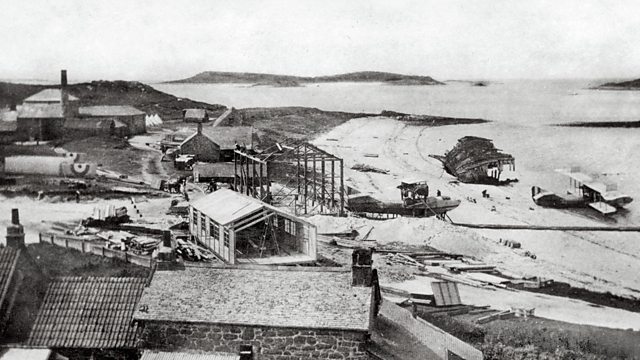New Grimsby, Cornwall: Hunting for German U-boats
Base of operations for a Canadian airman helping to protect Britainβs shipping lanes
Work to build a base on the main island at Portmellon on St Maryβs started in January 1917, but the site was found to be too exposed for the fragile aeroplanes An alternative was found at Tresco next to New Grimsbyβs beach as it was a little more sheltered.
ΒιΆΉΤΌΕΔ Cornwall has been given permission to use a fascinating voice recording of Canadian pilot Frederick βHollyβ Prime who put his memories on record as part of an oral history project in 1978:
βI asked to be sent to some islands off the West coast where they were getting started. It was a delightful place to live the weather was semi-tropical and all the fields were planted with flowers which were sold to Covent Garden in London. And also it had the best commanding officer that a person could wish for.β
The new arrivals including airmen, mechanics and a number of women support workers settled into island life mixing with the locals with the naval crews even attending church on a Sunday. The islanders had skills and manpower helping to screen some of the temporary accommodation Bell Tents from the wind in the same way because they protected their daffodil crops. After starting out as a tented camp the base later got wooden huts.
Eventually there was one principal aircraft hangar, a number of wooden huts, a big workshop and of course a slipway to bring the Flying Boats and Seaplanes up and down. The base was right on the sand so the flying boats could be beached rather than taking them up the slipway.
The aircraft were large, twin engine flying boats β an aeroplane with a hull providing buoyancy. There were some single engine aeroplanes too.
Aviation enthusiast Pete Londonβs excited to hear pilot Frederick Hollyβs first-hand account of his time as a pioneer of the skies piloting Trescoβs Flying Boats:
βHeβs great to listen to he comes across as a very modest unassuming man but what lies behind some of his stories we have today in the form of very simple uncluttered reports that have survived in documentary form but what he does is bring these reports to life with a really truly human experience.β (Pete London)
Frederick Primeβs granddaughter, Holly Smith, who now lives in London, and the rest of Fredβs descendants are hugely proud of their pioneering grandfather:
βThey would say things in the flight manual like donβt leave your plane (and this would be a land plane obviously and not a sea plane obviously) in a cow pasture because the cows probably will come and lick the glue off the canvas on the wings and you wouldnβt be able to fly out. So there were perils that we just hadnβt imaginedβ (Holly Smith)
One hundred years on there is still some evidence of the temporary sea plane base:
βThe old site has been built on since and is now a pleasant holiday place, but part of the old slipway survives but itβs been re-skimmed with concrete. There is also a row of holiday cottages which were once the ammunitions store and various concrete bases which supported wooden huts for the men and the officers.β (Pete London)
So some 21st Century visitors to Tresco might find themselves on a section of slipway or at the appropriately named βFlying Boat Clubβ, restaurant overlooking the waters where Curtiss Type aircraft bounced out towards the Atlantic to patrol for German submarines in 1917, and help ensure Britain supplies wouldnβt be cut off.
Location: RNAS Tresco, New Grimsby, (now the Flying Boat Club), Scilly TR24 0QQ
Image of RNAS Tresco, courtesy of Pete London, who also presents the story
Duration:
This clip is from
Featured in...
![]()
ΒιΆΉΤΌΕΔ Radio Cornwall—World War One At ΒιΆΉΤΌΕΔ
Places in Cornwall that tell a story of World War One
More clips from World War One At ΒιΆΉΤΌΕΔ
-
![]()
The loss of HMY Iolaire
Duration: 18:52
-
![]()
Scotland, Slamannan and the Argylls
Duration: 07:55
-
![]()
Scotland Museum of Edinburgh mourning dress
Duration: 06:17
-
![]()
Scotland Montrose 'GI Brides'
Duration: 06:41







